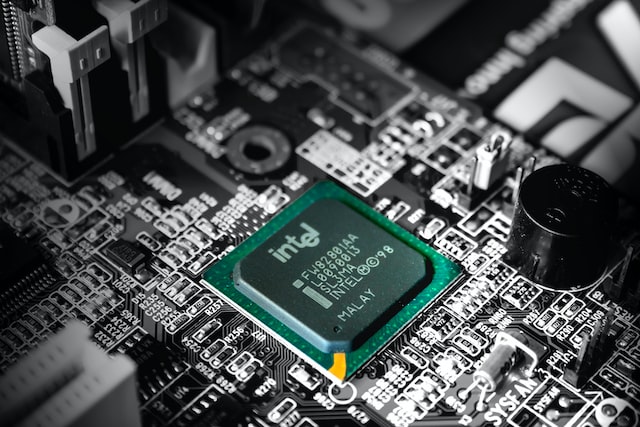Let’s understand competitor analysis before we get into the specifics of Intel. Competitor analysis is a strategic research method companies use to identify, evaluate, and understand their current and potential competitors within the market. It’s an essential business strategy component and instrumental in understanding the industry landscape.
The process usually involves the following steps:
- Identifying Key Competitors: The first step is to identify who your competitors are. These may be direct competitors (those who offer the same or similar products or services as you) or indirect competitors (those who provide different products or services but compete for the same consumer dollar).
- Analyzing Competitors’ Strategies and Objectives: Once competitors are identified, the next step is to understand their business strategies and objectives. This may involve analyzing their marketing materials, financial performance, customer reviews, or any public information available about the company.
- Assessing Competitors’ Strengths and Weaknesses: This step involves evaluating the identified competitors’ strengths and weaknesses. Strengths include unique products or services, strong brand recognition, and superior customer service. Weaknesses include poor product quality, weak customer service, or high prices.
- Understanding Competitors’ Products/Services: Understanding what your competitors offer and how your products or services compare is important. This could involve looking at features, quality, pricing, customer service, and marketing strategies.
- Observing Competitors’ Reaction Patterns: Some companies react more aggressively than others when faced with competition. Understanding these patterns lets you predict how these companies might respond to your business strategies.
- Drawing Conclusions and Formulating Strategy: The final step is to take all the information gathered from the analysis, draw meaningful conclusions, and use those to formulate or adjust your business strategies.
The main goal of a competitor analysis is to understand the competitive landscape, spot opportunities, and threats, and position your company most advantageously. It helps to inform strategic decisions, from product development to marketing and sales efforts. Now, let’s do a competitor analysis of Intel.
Here is the competitor analysis of Intel
Intel, a prominent player in the semiconductor and microprocessor industry, faces competition from various companies. The key competitors of Intel include:
AMD (Advanced Micro Devices)
- CPU Performance and Innovation: Intel and AMD continuously innovate to improve their CPUs’ performance, efficiency, and capabilities. This competition is most visible in the consumer desktop and laptop markets, as well as in servers and data centers. Each company regularly releases new processors with improved speed, power efficiency, and advanced features like integrated graphics and AI processing capabilities.
- Pricing Strategy: Price is a significant factor in competition. Intel and AMD often adjust their pricing strategies to offer better value propositions to consumers and businesses. AMD has historically positioned itself as a more affordable alternative to Intel, though this dynamic can shift depending on the specific product lines and market conditions.
- Market Segmentation: Both companies target various market segments, including consumer, enterprise, gaming, and data centers. They develop products tailored to the needs of each segment. For example, Intel’s Xeon processors are designed for enterprise and data center use, while its Core series caters to consumers and gamers. AMD has its Ryzen and EPYC series for similar segments.
- Technology Partnerships and Ecosystems: Intel and AMD work with other technology companies, including software developers, hardware manufacturers, and cloud service providers, to optimize their products for broader ecosystems. These partnerships can influence market preferences and adoption rates.
- Brand and Marketing: Brand reputation and marketing play a crucial role. With its long history and widespread recognition, Intel has a strong brand presence. AMD has been building its brand through strategic marketing and sponsorships, particularly in the gaming community.
- Research and Development (R&D): Continuous R&D is crucial for staying competitive. Both companies invest heavily in developing new technologies and improving existing ones. This includes advancements in semiconductor manufacturing processes, chip design, and new computing paradigms like AI and machine learning.
- Manufacturing and Supply Chain Management: Intel traditionally manufactured most of its chips in-house, while AMD outsources chip production to foundries like TSMC. However, Intel’s recent strategies include more outsourcing as well. Efficient manufacturing and supply chain management are critical, especially in global chip shortages.
- Legal and Regulatory Strategies: Occasionally, competition extends into legal and regulatory arenas, with companies engaging in lawsuits or antitrust investigations. These actions can impact their competitive strategies.
- Customer Service and Support: Providing effective support and building strong customer relationships are vital aspects of competition, influencing brand loyalty and repeat business.
NVIDIA
- Graphics Processing Units (GPUs): While NVIDIA is renowned for its leadership in the GPU market, especially in gaming and professional graphics, Intel has been working to strengthen its presence in this area. Intel’s integrated graphics are common in many PCs, and the company has been developing its own discrete GPU lines to compete directly with NVIDIA’s products.
- Data Centers and AI Computing: Both companies are strong competitors in the data center and artificial intelligence (AI) computing market. Due to their parallel processing capabilities, NVIDIA’s GPUs are widely used for AI and machine learning tasks. Intel, traditionally strong in the data center with its CPUs, is also focusing on AI and machine learning, not just through its CPUs but also through acquisitions like Nervana and Habana Labs and its own GPU developments.
- Autonomous Vehicles and Edge Computing: NVIDIA has been a front-runner in providing technology for autonomous vehicles and edge computing. Intel, through its Mobileye acquisition and other initiatives, is also a significant player in this space. Both companies are developing advanced processing solutions for real-time, on-device computing in vehicles and IoT devices.
- Software and Ecosystems: Intel and NVIDIA invest in software development and foster ecosystems supporting their hardware. This includes tools and libraries for AI, machine learning, high-performance computing, and more. These software ecosystems’ ease of use and robustness can be customer-deciding factors.
- Acquisitions and Partnerships: Both companies have made strategic acquisitions and partnerships to strengthen their positions in various markets. For example, NVIDIA’s acquisition of Mellanox expanded its capabilities in data center networking, a field where Intel also competes.
- Research and Development (R&D): Continuous innovation is key in technology, and both Intel and NVIDIA invest heavily in R&D to develop new technologies and improve existing ones. This includes hardware advancements, software, and new computing paradigms like AI and deep learning.
- Manufacturing and Supply Chain: NVIDIA relies on external foundries for its chip manufacturing, whereas Intel has traditionally been a significant player in chip manufacturing with its foundries. However, Intel’s recent strategy includes more diversification in manufacturing approaches, including using external foundries.
- Market Strategy and Branding: Both companies have strong brand identities and marketing strategies targeted at different market segments, from consumer electronics to enterprise solutions.
Qualcomm
- Mobile Processors and Modems: Qualcomm is a leader in the mobile processor and modem market, especially for smartphones and tablets, with its Snapdragon series. While Intel has had limited success in the mobile processor market, it has made significant investments in developing modems for mobile devices. Intel’s focus in this area has been on providing 4G and 5G connectivity components.
- 5G Technology and Infrastructure: Both companies are heavily invested in developing and deploying 5G technology. Qualcomm is known for its advancements in 5G modems and related technologies. Intel has been working on 5G infrastructure, including network equipment and specialized processors for 5G base stations.
- Internet of Things (IoT): The IoT market is a significant competition area. Intel offers a range of processors and solutions for IoT devices, focusing on high-performance computing at the edge. Qualcomm, with its strong presence in mobile technology, also offers a variety of products geared towards connected devices in the IoT ecosystem.
- Automotive Technology: As the automotive industry increasingly integrates advanced computing and connectivity features, Intel and Qualcomm compete to provide the necessary technology. This includes processors for in-car entertainment, navigation systems, and advanced driver-assistance systems (ADAS).
- Licensing and Patent Strategies: Qualcomm has a substantial portfolio of patents, especially in wireless technologies, and earns significant revenue from licensing these patents. While holding many patents, Intel has had a different approach, focusing more on product sales than licensing.
- Partnerships and Collaborations: Both companies engage in strategic partnerships and collaborations with other tech companies, automotive manufacturers, and telecommunications companies to expand their reach and integrate their technologies into a wide range of products and services.
- Research and Development (R&D): Intel and Qualcomm invest heavily in R&D to innovate and stay ahead in their respective fields. This includes improving existing technologies and exploring new areas like artificial intelligence, machine learning, and next-generation wireless technologies.
- Legal and Regulatory Engagements: The competition sometimes extends into legal and regulatory areas, with both companies having engaged in legal battles over patents and antitrust issues.
TSMC (Taiwan Semiconductor Manufacturing Company)
- Manufacturing Technology and Process Leadership: Both companies strive to lead in semiconductor manufacturing technology. TSMC is a world leader in advanced semiconductor manufacturing processes, offering services to clients, including companies that compete directly with Intel. Traditionally, Intel has been a leader in developing cutting-edge manufacturing processes for its chips but has faced challenges in advancing to smaller, more efficient process nodes in recent years.
- Foundry Services: Intel has traditionally focused on manufacturing its designs. However, with the launch of Intel Foundry Services (IFS), Intel has entered the market space that TSMC dominates, offering its manufacturing capabilities to external clients. This move puts Intel in direct competition with TSMC for foundry customers.
- Market Share in Advanced Node Manufacturing: TSMC holds a significant market share in manufacturing advanced semiconductor nodes (like 5nm, 3nm, and beyond). Through its foundry services and continued advancement in manufacturing technology, Intel competes for a share in this high-value segment.
- Client Acquisition and Retention: As Intel enters the foundry market, it competes to acquire and retain clients who might otherwise use TSMC’s services. This includes large tech companies and smaller firms needing advanced semiconductor manufacturing.
- Innovation and R&D: Both companies invest heavily in research and development to advance semiconductor manufacturing technology. This includes developing new manufacturing processes, improving yield rates, reducing costs, and increasing the performance and energy efficiency of the chips produced.
- Supply Chain and Capacity Management: Given the global demand for semiconductors, Intel and TSMC compete in supply chain management and manufacturing capacity. The ability to meet customer demands, especially during high demand or supply shortages, is a key competitive factor.
- Geopolitical and Trade Considerations: With the global nature of the semiconductor supply chain, both companies must navigate complex geopolitical and trade environments. This includes dealing with trade restrictions, regional market dynamics, and government relations.
- Strategic Partnerships and Collaborations: Both companies form partnerships to enhance their technological capabilities, expand their market reach, and improve their competitive positioning.
Texas Instruments
- Market Segmentation: Intel and TI target somewhat different semiconductor market segments. Intel is dominant in the personal computer, server, and data center processor markets. In contrast, Texas Instruments focuses on analog ICs, embedded processors, and other semiconductor products used in automotive, industrial, and consumer electronics. Their competition occurs in overlapping market segments, such as embedded solutions for industrial and automotive applications.
- Embedded and IoT Solutions: Both companies compete in the Internet of Things (IoT) and embedded systems markets. Intel offers processors and solutions geared towards high-performance computing and IoT applications. In contrast, TI provides a wide range of embedded processing products and analog solutions tailored for various applications in these fields.
- Automotive Industry: The automotive sector is becoming increasingly crucial for semiconductor companies due to the growing use of electronics in vehicles. Through its Mobileye subsidiary and other initiatives, Intel offers solutions for autonomous driving and advanced driver-assistance systems (ADAS). With its range of analog and embedded processing products, TI also serves the automotive industry, particularly in areas like infotainment systems, power management, and sensor applications.
- Innovation and Technology Development: Both companies invest heavily in research and development. Intel’s R&D focuses on advancing computing technology, particularly AI, 5G, and next-generation semiconductor processes. TI invests in developing its analog and embedded processing technologies, focusing on power efficiency and miniaturization.
- Strategic Partnerships and Collaborations: Intel and TI engage in strategic partnerships and collaborations to strengthen their positions in various markets. These partnerships help them to integrate their technologies into a broader ecosystem of products and services.
- Supply Chain and Manufacturing Capabilities: While Intel has traditionally manufactured most of its chips in-house, TI outsources a significant portion of its manufacturing. Both companies face the challenge of managing complex supply chains and meeting global demand, especially during semiconductor shortages.
- Customer Base and Market Reach: Intel and TI have different customer bases due to their product specializations. Intel’s primary customers are in the PC, server, and data center markets, while TI’s customers are more diverse, spanning industries like automotive, industrial, personal electronics, and telecommunications.











